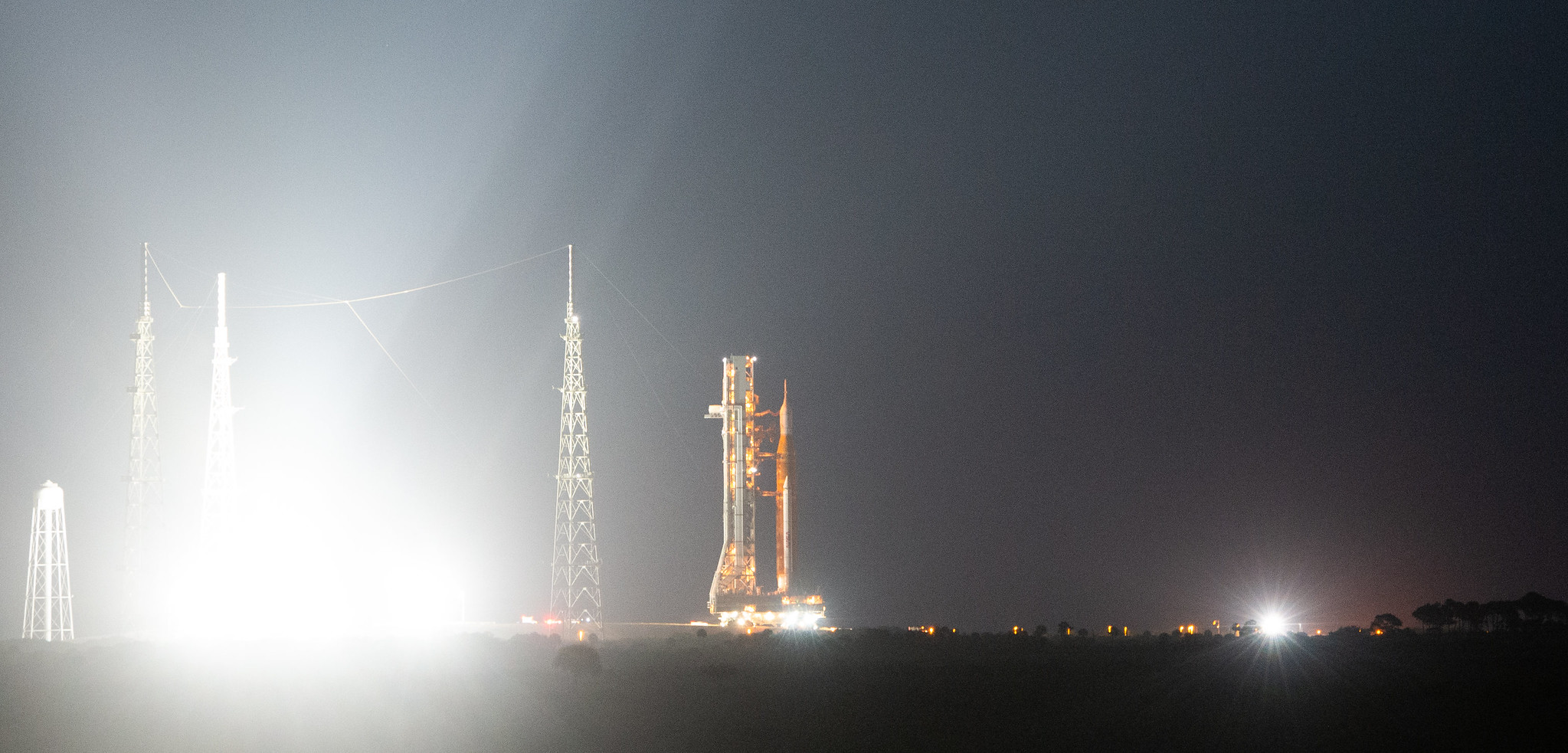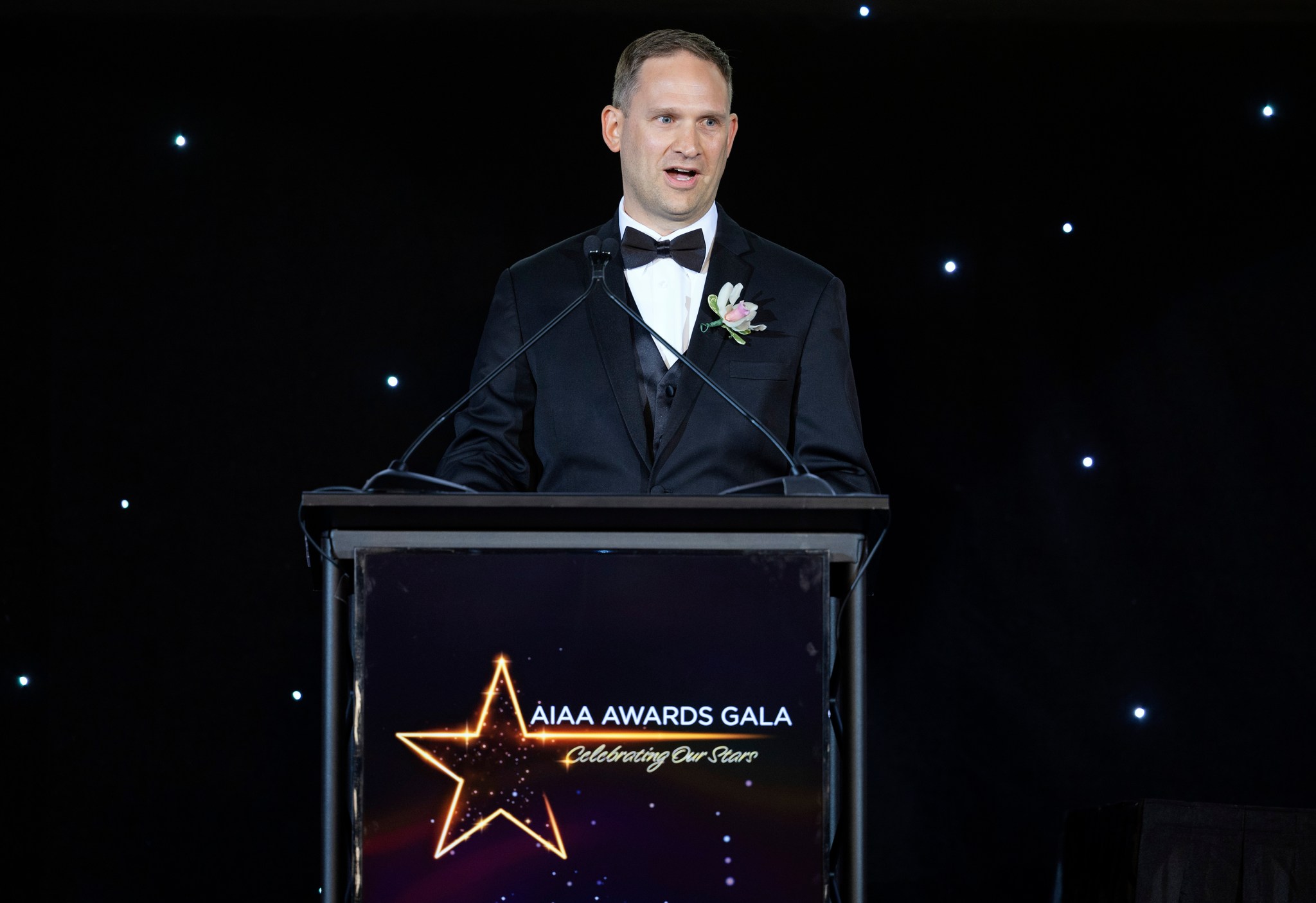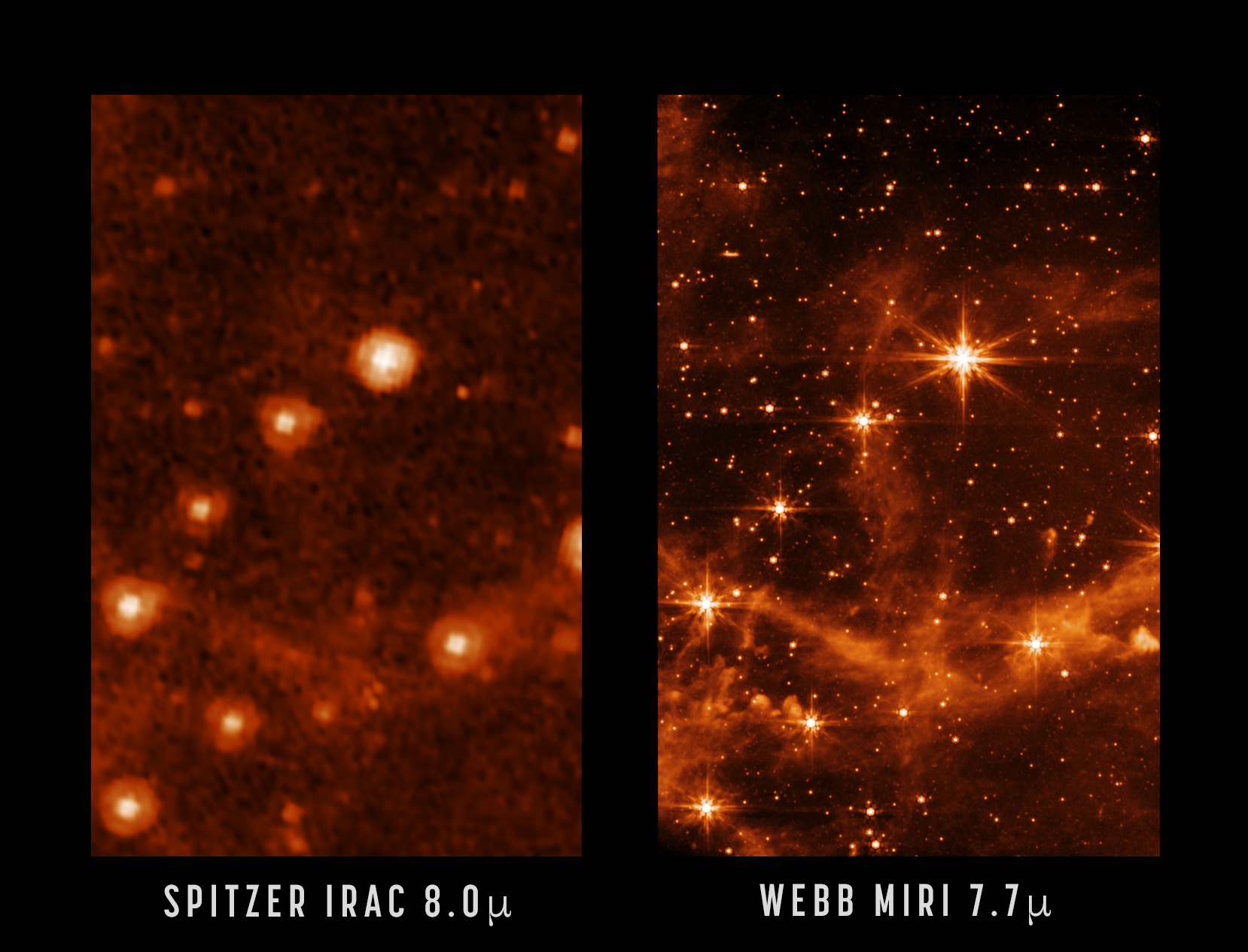- Artemis I Rocket, Spacecraft Prepare for Return to Launch Pad to Finish Test
- NASA, ESA Astronauts Safely Return to Earth
- Paul Gradl Named AIAA’s Engineer of the Year
- Webb Telescope’s MIRI Hints at New Possibilities for Science
- New NASA Black Hole Sonifications with a Remix
- ‘Fire in the Hole’: Stennis Preparing Stand for RS-25 Testing
Artemis I Rocket, Spacecraft Prepare for Return to Launch Pad to Finish Test
Since returning to the Vehicle Assembly Building at NASA’s Kennedy Space Center, ground systems teams have worked to prepare the Artemis I Space Launch System (SLS) rocket and Orion spacecraft to roll back to Launch Pad 39B in late May to complete the wet dress rehearsal test in June.
Inside the Vehicle Assembly Building, engineers replaced a helium check valve on the interim cryogenic propulsion stage. Engineers have inspected the valve and found a small piece of rubber that prevented the valve from sealing correctly. Teams are looking at possible sources of the debris but did not see any issues with the valve itself, and plan to test the newly installed valve to confirm it is operating as expected.
Engineers also performed tests to address a hydrogen leak on one of two tail service mast umbilicals between the mobile launcher and the rocket. These umbilicals provide liquid oxygen and liquid hydrogen propellants, as well as electrical connections, from the mobile launcher to the rocket’s core stage during the launch countdown. Teams conducted leak checks on all the joints and tightened several flange bolts, or fasteners that act as a washer to increase the compression strength, that can loosen over time and were the most likely source of the leak. Teams re-tightened the flange bolts on the liquid hydrogen, liquid oxygen, and core stage intertank umbilicals. Engineers have not detected leaks in subsequent testing at ambient air temperature and will continue to monitor for leaks when loading the super cold propellants at the launch pad.
The supplier that provides gaseous nitrogen for operations during tanking is upgrading its facility to meet the requirements for the next wet dress rehearsal attempt and the Artemis I launch. Teams are on track to complete the work and test the system to ensure the system is ready for tanking. During the test, teams pump gaseous nitrogen into dry structures to protect avionics during propellant loading.
Once all major work is completed, teams will retract the working platforms and prepare the integrated SLS and Orion for the second journey to the launch pad. NASA will announce dates for roll to the pad and the next wet dress rehearsal attempt once work is nearing completion inside the Vehicle Assembly Building.
NASA, ESA Astronauts Safely Return to Earth
NASA’s SpaceX Crew-3 astronauts aboard the Dragon Endurance spacecraft safely splashed down May 6 in the Gulf of Mexico off the coast of Florida, completing the agency’s third long-duration commercial crew mission to the International Space Station. The international crew of four spent 177 days in orbit.
NASA astronauts Kayla Barron, Raja Chari, and Tom Marshburn, and European Space Agency astronaut Matthias Maurer returned to Earth in a parachute-assisted splashdown at 12:43 a.m. EDT. Teams aboard SpaceX recovery vessels recovered the spacecraft and astronauts. After returning to shore, the astronauts flew to NASA’s Johnson Space Center.
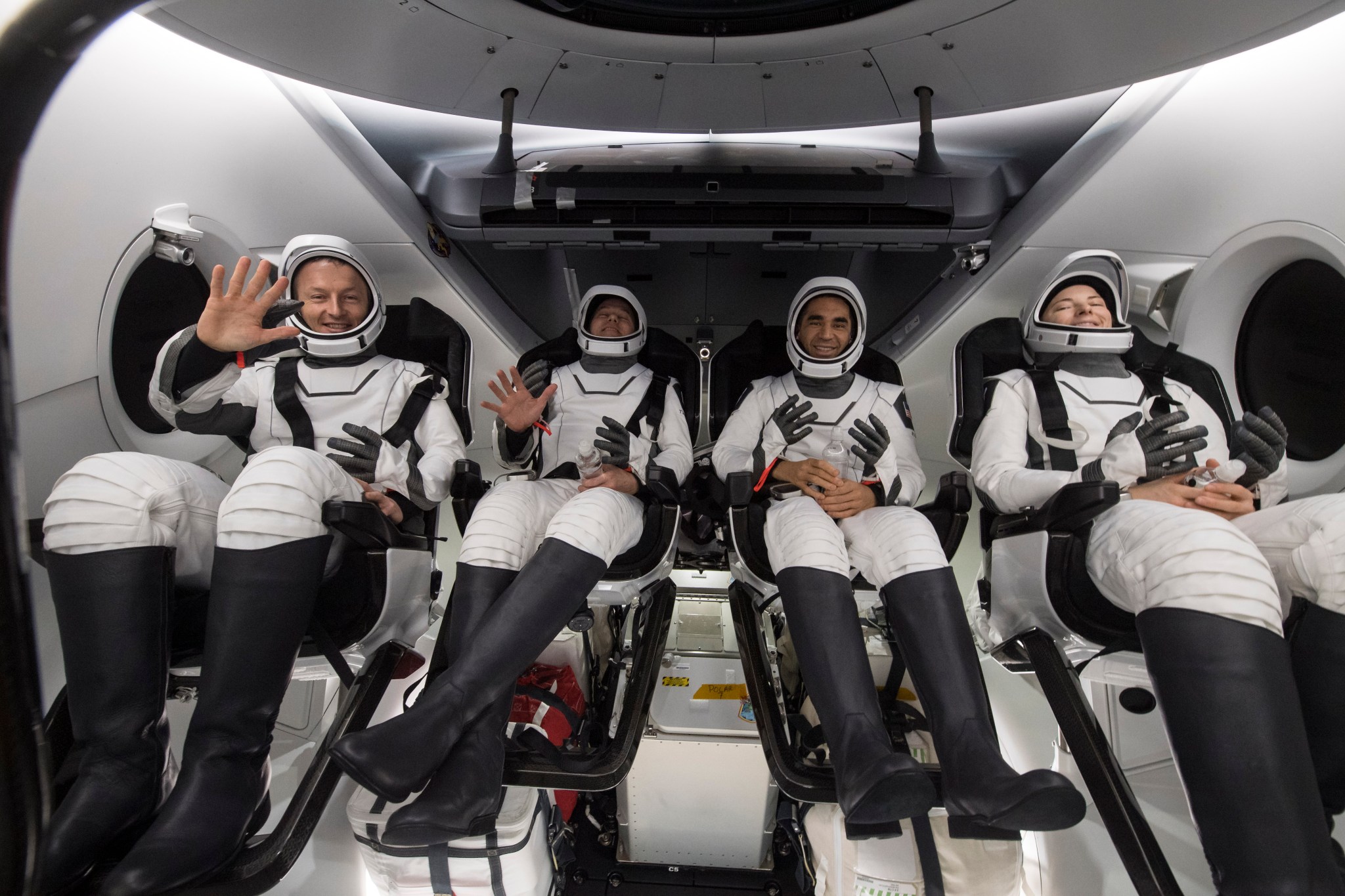
Credits: NASA/Aubrey Gemignani
“NASA’s partnership with SpaceX has again empowered us to deliver a crew safely to the space station and back, enabling groundbreaking science that will help our astronauts travel farther out into the cosmos than ever before. This mission is just one more example that we are truly in the golden era of commercial spaceflight,” NASA Administrator Bill Nelson said. “Kayla, Raja, Tom, and Matthias, thank you for your service and welcome home!”
The Crew-3 mission launched Nov. 10 on a Falcon 9 rocket from NASA’s Kennedy Space Center. Nearly 24-hours after liftoff, Nov. 11, Endurance docked to the Harmony module’s forward space station port. The astronauts undocked from the same port at 1:05 a.m. May 5, to begin the trip home.
Barron, Chari, Marshburn, and Maurer traveled 75,060,792 miles during their mission, spent 175 days aboard the space station, and completed 2,832 orbits around Earth. Marshburn has logged 339 days in space over his three flights. The Crew-3 mission was the first spaceflight for Barron, Chari, and Maurer.
The Crew-3 astronauts contributed to a host of science and maintenance activities and technology demonstrations. In addition, they conducted three spacewalks to perform station maintenance and upgrades outside the space station. This brought the total number of spacewalks for Marshburn to five, while Chari and Barron have each completed two, and Maurer one.
Crew-3 built on previous work investigating how fibers grow in microgravity, used hydroponic and aeroponic techniques to grow plants without soil or other growth material, captured imagery of their retinas as part of an investigation that could detect eye changes of astronauts in space automatically in the future, and performed a demonstration of technology that provides measurements of biological indicators related to disease and infection, among many other scientific investigations. The astronauts took hundreds of photos of Earth as part of the Crew Earth Observation investigation, one of the longest-running investigations aboard the space station, which helps track natural disasters and changes to our home planet.
The Payload Operations Integration Center at NASA’s Marshall Space Flight Center operates, plans, and coordinates science experiments aboard the station 365 days a year, 24 hours a day. The payload operations team coordinates all U.S., European, Japanese, and Canadian scientific and commercial experiments on the station, synchronizes payload activities of international partners, and directs communications between station crew members and researchers around the world.
Endurance will return to Florida for inspection and processing at SpaceX’s Dragon Lair, where teams will examine the spacecraft’s data and performance throughout the flight.
The Crew-3 flight is part of NASA’s Commercial Crew Program and its return to Earth follows on the heels of NASA’s SpaceX Crew-4 launch, which docked to the station April 27, beginning another science expedition.
The goal of NASA’s Commercial Crew Program is safe, reliable, and cost-effective transportation to and from the space station. This already has provided additional research time and has increased the opportunity for discovery aboard humanity’s microgravity testbed for exploration, including helping NASA prepare for human exploration of the Moon and Mars.
The commercial crew team at Marshall has a long working relationship with SpaceX, having worked with the commercial partner to improve safety and reliability of the Merlin engines, stage propulsion, Draco and Super Draco thrusters, the abort and flight termination systems, structures, materials and processes, fracture control, and integrated performance analyses.
Paul Gradl Named AIAA’s Engineer of the Year
By Lance D. Davis
Paul Gradl, a principal engineer at NASA’s Marshall Space Flight Center, received a 2022 Premier Award for Engineer of the Year from the American Institute of Aeronautics and Astronautics, or AIAA, during its awards gala, held April 27 at the Ronald Reagan Building and International Trade Center in Washington, D.C.
Gradl was recognized by the institute for his exceptional engineering and innovation, developing metal additive manufacturing techniques to meet NASA missions and industry needs.
“I am very honored to be standing here accepting this award, building upon my mentors’ work, and inspiring the next generation … and I’m grateful to all my colleagues across industry, government, and academia for your support,” Gradl told an audience of the gala’s more than 400 attendees. “Together, we will go back to the Moon and on to explore Mars.”
Gradl has led several projects across NASA for the additive manufacturing of liquid rocket engine combustion devices and supported a variety of development and flight programs for over 18 years. He has also championed and contributed to the agency’s Rapid and Analysis Manufacturing Propulsion Technology project, or RAMPT, helping to advance manufacturing methods, such as 3D printing, that will improve the performance and reduce the production costs of rocket thrust chamber assemblies and other projects.
“Paul is an exemplary engineer and an exceptional servant leader – innovative, collaborative, and driven,” Mary Beth Koelbl, director of Marshall’s Engineering Directorate, said. “He is also a role model to many, both internal to NASA and in the broader industrial base. We are so proud of him and all that he has accomplished.”
Gradl has authored and co-authored more than 80 journal articles and conference papers, holds five patents, and regularly teaches courses in additive manufacturing for spaceflight.
The recently named AIAA Engineer of the Year is also the recipient of numerous NASA and industry awards, including two NASA Exceptional Achievement Medals, NASA Exceptional Service Medal, NASA Research and Technology, NASA Space Flight Honoree, and recognized by 3Dnatives as one of the “Most Influential Personalities of Additive Manufacturing 2020.”
With nearly 30,000 individual members from 91 countries, and 95 corporate members, AIAA is the world’s largest technical society dedicated to the global aerospace profession.
Gradl is an associate fellow of AIAA and very active in STEM engagement. He serves on several committees across the industry, and chairs various sessions at leading conferences on additive manufacturing. Currently, he is co-authoring and co-editing a textbook titled “Metal Additive Manufacturing for Propulsion Applications” under the AIAA Progress in Astronautics and Aeronautics series.
“One of the joys of our work at NASA is inspiring future generations of explorers,” he said.
Davis is a public affairs officer in Marshall’s Office of Strategic Analysis & Communications.
Webb Telescope's MIRI Hints at New Possibilities for Science
NASA’s James Webb Space Telescope is aligned across all four of its science instruments, as seen in a previous engineering image showing the observatory’s full field of view. Now, take a closer look at that same image, focusing on Webb’s coldest instrument: The Mid-Infrared Instrument, or MIRI.
The MIRI test image – at 7.7 microns – shows part of the Large Magellanic Cloud. This small satellite galaxy of the Milky Way provided a dense star field to test Webb’s performance.
A close-up of the MIRI image is compared to a past image of the same target taken with NASA’s Spitzer Space Telescope’s Infrared Array Camera – at 8.0 microns. The retired Spitzer telescope was one of NASA’s Great Observatories and the first to provide high-resolution images of the near- and mid-infrared universe. Webb, with its significantly larger primary mirror and improved detectors, will allow astronomers to see the infrared sky with improved clarity, enabling even more discoveries.
For example, Webb’s MIRI image shows the interstellar gas in unprecedented detail. You can see the emission from “polycyclic aromatic hydrocarbons,” or molecules of carbon and hydrogen that play an important role in the thermal balance and chemistry of interstellar gas. When Webb is ready to begin science observations, studies such as these with MIRI will help give astronomers new insights into the birth of stars and protoplanetary systems.
In the meantime, the Webb team has begun the process of setting up and testing Webb’s instruments to begin science observations this summer.
A team at NASA’s Marshall Space Flight Center spent more than two decades working on Webb, primarily focusing on development and testing of the mirrors in extreme cold temperatures at which the telescope operates.
New NASA Black Hole Sonifications with a Remix
Since 2003, the black hole at the center of the Perseus galaxy cluster has been associated with sound. This is because astronomers discovered that pressure waves sent out by the black hole caused ripples in the cluster’s hot gas that could be translated into a note – one that humans cannot hear some 57 octaves below middle C. Now a new sonification brings more notes to this black hole sound machine. This new sonification – the translation of astronomical data into sound – was released for NASA’s Black Hole Week.
In some ways, this sonification is unlike any other done before (1, 2, 3, 4) because it revisits the actual sound waves discovered in data from NASA’s Chandra X-ray Observatory. The popular misconception that there is no sound in space originates with the fact that most of space is essentially a vacuum, providing no medium for sound waves to propagate through. A galaxy cluster, on the other hand, has copious amounts of gas that envelop the hundreds or even thousands of galaxies within it, providing a medium for the sound waves to travel.
In this new sonification of Perseus, the sound waves astronomers previously identified were extracted and made audible for the first time. The sound waves were extracted in radial directions, that is, outward from the center. The signals were then resynthesized into the range of human hearing by scaling them upward by 57 and 58 octaves above their true pitch. Another way to put this is that they are being heard 144 quadrillion and 288 quadrillion times higher than their original frequency – s quadrillion is 1,000,000,000,000,000.
A new sonification of the black hole in Messier 87, or M87, was also released. Studied by scientists for decades, M87 gained celebrity status in science after the first release from the Event Horizon Telescope project in 2019. This new sonification does not feature the Event Horizon Telescope’s data, but rather looks at data from other telescopes that observed M87 on much wider scales at roughly the same time.
More sonifications of astronomical data, as well as additional information on the process, can be found at the “A Universe of Sound” website.
These sonifications were led by the Chandra X-ray Center and included as part of NASA’s Universe of Learning program with additional support from Hubble/NASA’s Goddard Space Flight Center. The collaboration was driven by visualization scientist Kimberly Arcand of the Chandra X-ray Center, and astrophysicist Matt Russo and musician Andrew Santaguida of the SYSTEMS Sound project.
NASA’s Marshall Space Flight Center manages the Chandra program. The Smithsonian Astrophysical Observatory’s Chandra X-ray Center controls science from Cambridge Massachusetts and flight operations from Burlington, Massachusetts. NASA’s Universe of Learning materials are based upon work supported by NASA under cooperative agreement award number NNX16AC65A to the Space Telescope Science Institute, working in partnership with California Institute of Technology/Infrared Processing and Analysis Center, Harvard & Smithsonian Center for Astrophysics, and NASA’s Jet Propulsion Laboratory.
‘Fire in the Hole’: Stennis Preparing Stand for RS-25 Testing
When cooking on a grill, one may notice that certain areas of the grate burn hotter than others. A similar phenomenon affects test stand flame deflectors at NASA’s Stennis Space Center, albeit involving considerably hotter rocket engine exhaust.
Ensuring the flame deflectors can withstand ultra-hot temperatures requires careful and precise work. Even now, Stennis teams are engaged in a critical – and intricate – maintenance project to protect the flame deflector on the Fred Haise Test Stand, where RS-25 engines for NASA’s Space Launch System (SLS) rocket are tested.
“People would be surprised at what goes into maintaining our test infrastructure,” said Jared Grover, NASA manager leading the Fred Haise Test Stand project. “The test stands and facilities are massive and durable, but there is a level of detailed and even delicate work needed to ensure they function as needed.”
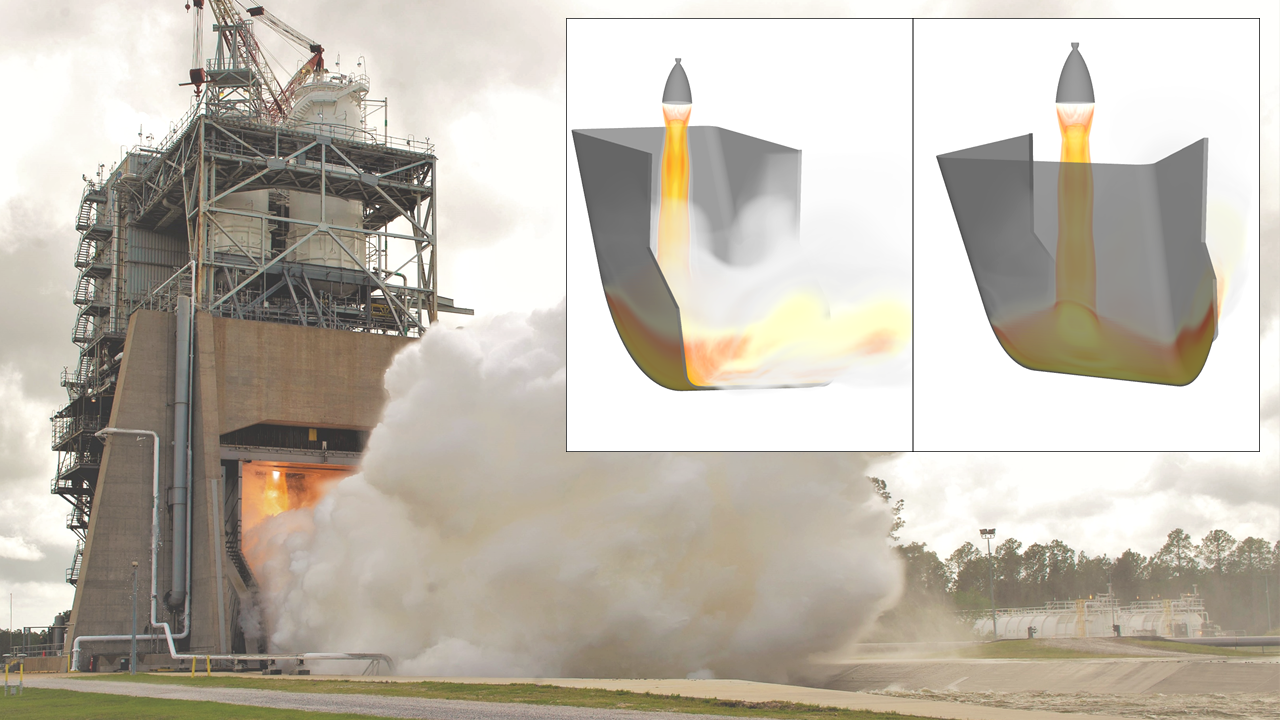
Credits: NASA
During testing on the stand, for instance, an RS-25 engine’s combustion chamber reaches 6,000 degrees Fahrenheit. Its exhaust plume hits the test stand’s J-shaped flame deflector at temperatures around 5,000 degrees Fahrenheit and sends a cascade of shockwaves throughout the structure.
The exhaust is cooled by high-pressure water sprayed into the test stand flame deflector through thousands of 5/32-inch holes. Without the 170,000 gallons of water pumped every minute from the nearby High Pressure Industrial Water Facility, the carbon-steel flame deflector would melt under the superhot exhaust plume.
However, just as with a backyard barbecue grill, the exhaust hits some parts of the flame deflector more directly – and with more heat – than others. To offset the effect, the pattern of holes must be precise and uniquely tailored for a particular test project.
To prolong the life of the test stand and reduce ongoing maintenance costs, crews are in the process of performing critical modifications on the stand’s flame deflector. A key part of the work is drilling a new, highly specialized hole pattern to improve water cooling and protect the infrastructure. The hole pattern will be uniquely tailored for the RS-25 testing program.
“An engine plume is essentially a supersonic blowtorch,” Stennis engineer Danny Allgood said. “There are extreme forces at play, such as high temperature and pressure, that are factored in to where we need to drill additional water-cooling holes. The objective is to ensure a layer of water constantly flows over the deflector during testing.”
Allgood is NASA’s computational fluid dynamics subject matter expert at Stennis. For the test stand project, he led in mapping out the flame deflector’s hottest region, known as the “impingement zone,” where the plume directly impinges on the deflector.
Having tested rocket engines and stages dating back to the Apollo missions, the test stand has a proven history of bearing the same temperatures and forces produced by a rocket engine during launch. However, testing RS-25 engines for SLS use – in upcoming Artemis missions to the Moon and eventual flights to Mars – has presented a new set of challenges. The engines sit at a lower point in the test stand – closer to the flame deflector – and operate at higher power levels than engines from some previous test programs.
Moreover, RS-25 engine testing entails gimbaling – redirecting the aim of the engine’s plume around a tight circular axis, a key function for “steering” a rocket by controlling its trajectory in flight.
Allgood conducted computational analysis of several previous RS-25 gimbal tests to track and measure how gimbaling affects the impingement zone. His analysis accurately determined where there is an increased need for additional water-cooling holes.
“Imagine a flashlight, signifying an RS-25 engine, shining down on a flat sheet of paper, producing a circular halo of light,” Allgood said, explaining the analysis process. “Now, imagine tilting that sheet of paper like a ramp, sort of like the shape of the flame deflector. That halo of light – the engine plume – will now look more like an ellipse, or egg, longer than it is wide. With engine gimbaling, the reach of the engine plume’s ‘ellipse’ is even wider and longer, and that represents the area on the flame deflector in need of more water cooling.”
In the center of the ellipse, or zone of impingement, a team of machinists will drill additional holes at an angle of about 60 degrees – slightly off-vertical – in a grid-like pattern, reaching a density of 72 holes per square foot. Some existing holes in this area may be plugged if they do not conform to the planned pattern.
In the remainder of the egg-shaped zone of impingement, more holes – at the same angle of about 60 degrees – will be drilled to a density of 20 holes per square feet, since the exhaust plume from a gimbaling engine will only briefly be directed at this area. The hole angling is intended to help water flow more easily down the flame deflector and insulate the surface from the engine plume as much as possible.
Read the entire story here.



























